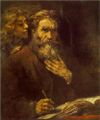Category:Matthew (subject)
Matthew (1st century CE) was, according to Christian tradition, one of the Twelve Apostles of Jesus of Nazareth, and one of the four evangelists.
< Recruiting the Tax Collector -- Choosing of the Twelve -- Gathering of the Twelve -- Martyrdom of Matthew -- Relics of Matthew >
Overview
In the Gospels of Mark, Matthew and Luke-Acts, Matthew is mentioned in the lists of the Twelve (Mk 3:18; Mt 10:3; Lk 6:15; Acts 1:13), who were with Jesus and were leaders of the nascent Christian movement after his death.
The Gospel of Matthew is the only source to include a narrative about the calling of Matthew and to consistently identify him as "the tax collector": "As Jesus passed on from there, he saw a man called Matthew sitting at the tax booth, and he said to him, Follow me. And he rose and followed him" (Mt 9:9; see also 10:3). In the parallel accounts of Mark (2:13-14) and Luke (5:27-28), however, the name of the tax collector is "Levi" ("the son of Alphaeus" according to Mark).
The Gospel of Thomas refers to Matthew as answering the question about Jesus' identity with the words: "You are a wise philosopher" (13). No reference to Matthew can be found in the Gospel of John, or in Paul or any other early sources.
The later Christian tradition would ordinarily identify Matthew with Levi and would attribute to him the authorship of the Gospel of Matthew. After the death of Jesus, Matthew-Levi is said to have preached for many years to Jews in Judea, and then to Gentiles in Ethiopia (the region to the south of the Caspian Sea), Macedonia, Persia, and Parthia. There are also stories about his martyrdom, although the Christian tradition is not consistent whether he was killed or died of natural death, or about the kind of penalty inflicted on him.
According to a Christian tradition, Matthew suffered his martyrdom in Naddaver, Ethiopia, and was buried there, until his remains were translated to Salerno on May 6, 954, where they are still venerated (see Relics of Matthew).
Matthew in ancient sources
Matthew, in the arts
The traditional iconography of Matthew-Levi focuses on three events of his life: (a) the calling by Jesus; (b) the writing of the Gospel (usually assisted by an angel); and (c) the martyrdom. There are many works of art depicting Matthew, including some celebrated masterpieces, by Caravaggio (1600-02), Guido Reni (1640), and Rembrandt (1661). However, with the conspicuous exception of Caravaggio, the scenes of the life of Matthew never developed into an autonomous narrative cycle. As one of the Twelve, Matthew is present in all fictional narratives of the life of Jesus, very seldom in a prominent role, almost never as a protagonist.
- See Matthew (arts)
Matthew, in scholarship
Studies on the historical Matthew are made impossible by the lack of evidence, and restricted to introductory notes on the authorship of the Gospel of Matthew or on the legends surrounding his life.
Related categories
External links
Pages in category "Matthew (subject)"
The following 8 pages are in this category, out of 8 total.









